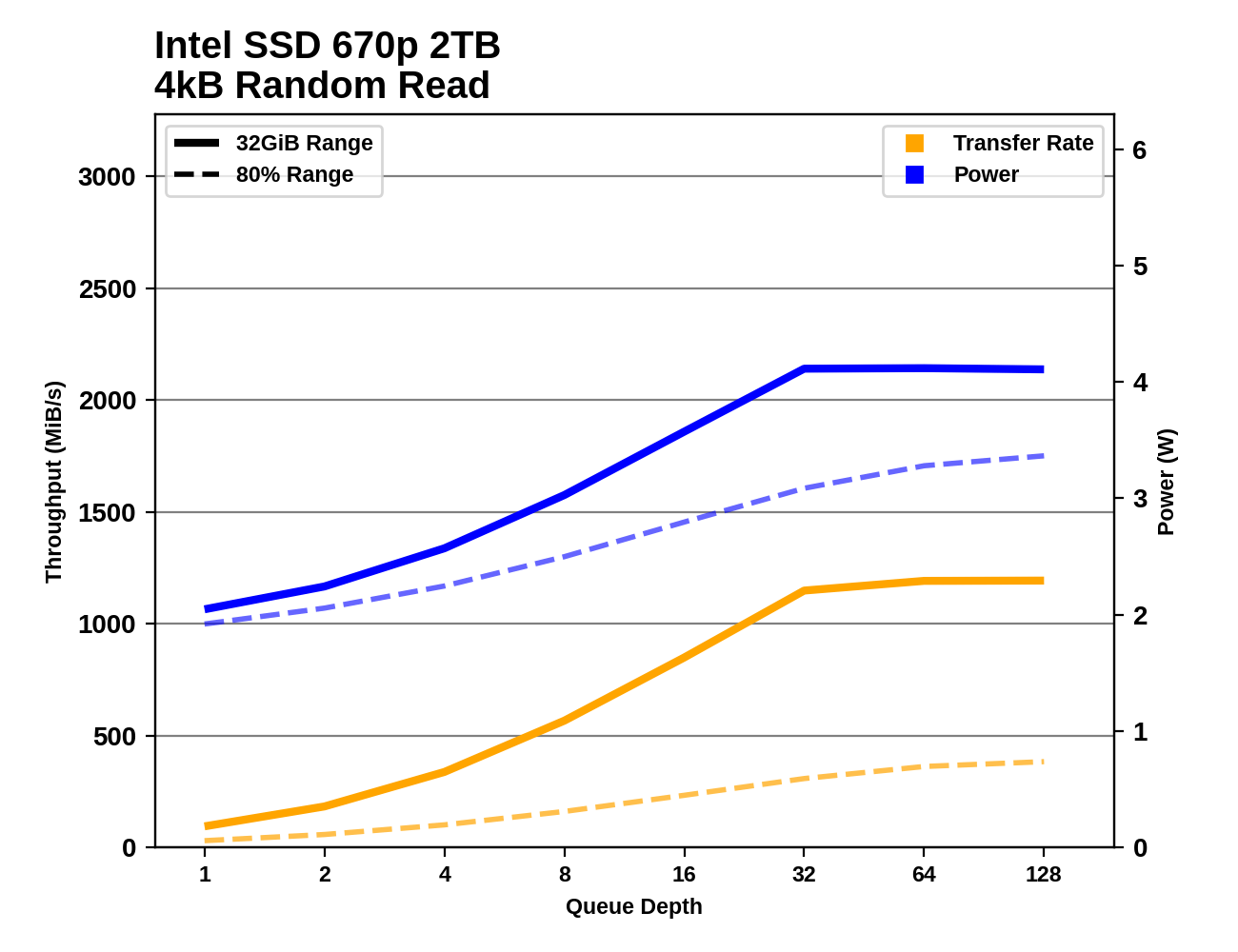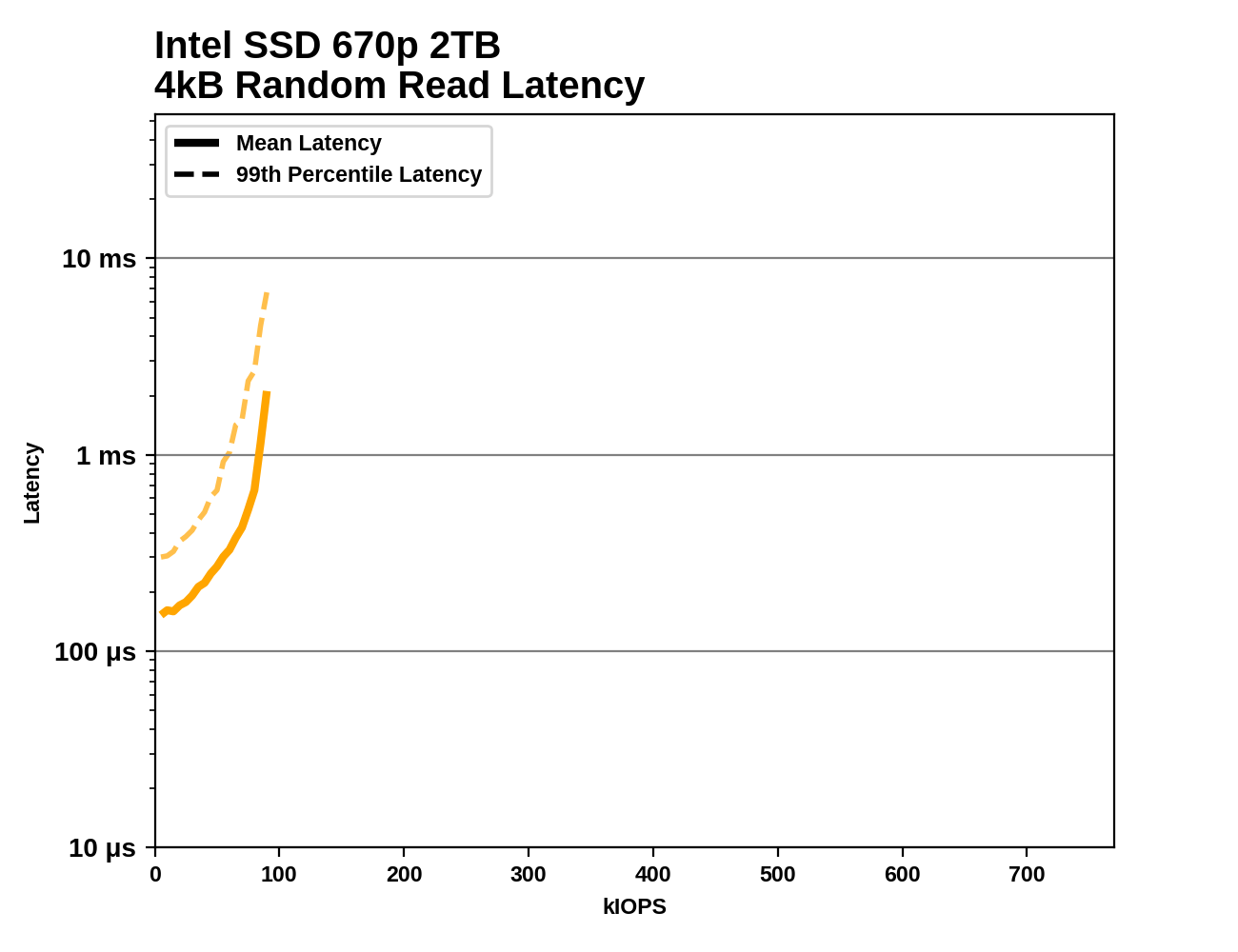The Intel SSD 670p (2TB) Review: Improving QLC, But Crazy Pricing?!?
by Billy Tallis on March 1, 2021 12:00 PM ESTBurst IO Performance
Our burst IO tests operate at queue depth 1 and perform several short data transfers interspersed with idle time. The random read and write tests consist of 32 bursts of up to 64MB each. The sequential read and write tests use eight bursts of up to 128MB each. For more details, please see the overview of our 2021 Consumer SSD Benchmark Suite.
 |
|||||||||
| Random Read | Random Write | ||||||||
| Sequential Read | Sequential Write | ||||||||
For quite a while, NVMe SSDs with Silicon Motion controllers have been delivering some of the best QD1 burst random read performance scores. The Intel SSD 670p pushes this even further, when the test is only hitting the SLC cache. When testing against an 80% full drive, the burst random read performance is faster than most other QLC drives but slower than any good TLC drive.
For QD1 random writes, the 670p is actually slightly slower than the 660p when testing a mostly-full drive, though it is again competitive with more high-end TLC drives when writing to the SLC cache. For both sequential reads and sequential writes, the 670p offers very good QD1 throughput for a PCIe 3.0 drive, and is much improved over the 660p that is seriously bottlenecked by its low-end controller.
Sustained IO Performance
Our sustained IO tests exercise a range of queue depths and transfer more data than the burst IO tests, but still have limits to keep the duration somewhat realistic. The primary scores we report are focused on the low queue depths that make up the bulk of consumer storage workloads. For more details, please see the overview of our 2021 Consumer SSD Benchmark Suite.
 |
|||||||||
| Random Read | Throughput | Power | Efficiency | ||||||
| Random Write | Throughput | Power | Efficiency | ||||||
| Sequential Read | Throughput | Power | Efficiency | ||||||
| Sequential Write | Throughput | Power | Efficiency | ||||||
As with the burst IO scores, the longer sustained IO tests show the Intel 670p doing very well with sequential reads or writes: the performance doesn't betray the fact that it's using QLC NAND, and the power efficiency is typical of a last-generation controller. For random reads or writes, the performance at low queue depths is similarly great when testing the SLC cache, but testing across an 80% full drive knocks performance down to typical entry-level NVMe and mainstream SATA territory. Random writes in particular are disappointing on the mostly-full drive: it's slower than the 660p and the Phison E12-based Corsair MP400, though still several times faster than the DRAMless Mushkin Helix-L.
 |
|||||||||
| Random Read | |||||||||
| Random Write | |||||||||
| Sequential Read | |||||||||
| Sequential Write | |||||||||
The Intel 670p is fairly well-behaved through the sustained IO tests as the queue depth ramps up. Random reads saturate around QD32, random writes around QD8, and sequential transfers at QD2. Performance is very consistent after the drive reaches its full speed; the only big drop comes at the very end of the sequential write test on a mostly-full drive, when the SLC cache finally runs out while testing at QD128. This is pretty much never going to happen during ordinary consumer workloads.
Random Read Latency
This test illustrates how drives with higher throughput don't always offer better IO latency and Quality of Service (QoS), and that latency often gets much worse when a drive is pushed to its limits. This test is more intense than real-world consumer workloads and the results can be a bit noisy, but large differences that show up clearly on a log scale plot are meaningful. For more details, please see the overview of our 2021 Consumer SSD Benchmark Suite.
 |
|||||||||
Taking a closer look at random read throughput and latency, the Intel 670p fares better than most of the other QLC drives, save for the 8TB Sabrent Rocket Q. The 670p has slightly worse performance than the DRAMless TLC Mushkin Helix-L. The throughput achieved by the 670p is similar to mainstream TLC SATA drives, but the latency is considerably higher: the SATA drives are bottlenecked by the SATA link itself, while the 670p's bottleneck is on the NAND side, which causes latency to spike as the drive is pushed to its limit.










72 Comments
View All Comments
crimson117 - Tuesday, March 2, 2021 - link
Why in the world would you pay $329 for a 2TB QLC PCIe 3.0 drive?octacore - Tuesday, March 2, 2021 - link
https://www.newegg.com/intel-2tb-670p-series/p/N82...Which is $249 as of this reply. It is actual sale price, that's matter
Spunjji - Thursday, March 4, 2021 - link
That's still at least $50 outside of having a worthwhile cost/performance trade-off, thoughbernstein - Tuesday, March 2, 2021 - link
@anandtech: really missing ssd reviews for the SN550, SN850but as always: GREAT REVIEW !
Billy Tallis - Tuesday, March 2, 2021 - link
SN850 should be my next review up. And my SN550 sample arrived yesterday. Test results for that will be in Bench by the end of the week. I'm not currently expecting to do a review specifically of the SN550, but it'll be included in a review planned for next week.Spunjji - Thursday, March 4, 2021 - link
Great stuff. Thank you!CaedenV - Tuesday, March 2, 2021 - link
Haven't all of Intel's SSDs come out with a high MSRP and then actually sell for much less? Pretty sure my Sammy Evo drive was cheaper than this 2 years ago though lol.Billy Tallis - Tuesday, March 2, 2021 - link
High launch MSRPs are common for lots of brands, including Intel. But these prices seem especially egregious, though I haven't yet tried to systematically compare the MSRP vs street price gaps for other SSD launches. Even if this launch isn't actually as much of an outlier as it feels like, this is still a bit of a ridiculous business practice, and it's hard not to take these prices at face value when that's what they're actually charging on Newegg, Amazon, etc. I'd love to know how much volume these companies realistically expect to move at inflated prices before aligning with the rest of the market.But Intel's previous 6-series drives have all eventually made it down to pretty good price points.
octacore - Tuesday, March 2, 2021 - link
Yeah, just on the 2nd day general availability, NewEgg also marked $25 off from launching fay. Don't take MSRP too seriously,Oxford Guy - Tuesday, March 2, 2021 - link
No. MSRP is serious.We wouldn’t be discussing it if it were not.
It wouldn’t be featured in headlines if it were not.
It’s very important, for instance, that the latest Nvidia card is selling out at $600 despite having a vastly lower MSRP. If you think otherwise you’re simply wrong.